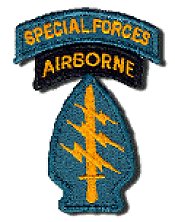Nam Dong, Lang Vei, Dak To, A Shau, Plei Mei - these were just some of the places Special Forces troops fought and died for during their 14-year stay in South Vietnam. It was a stay that began in June 1956 when the original 16 members of the 14th Special Forces Operational Detachment entered Vietnam to train a cadre of indigenous Vietnamese Special Forces teams. In that same year, on October 21, the first American soldier died in Vietnam - Captain Harry G. Cramer Jr. of the 14th SFOD.
Throughout the remainder of the 1950s and early 1960s, the number of Special Forces military advisors in Vietnam increased steadily. Their responsibility was to train South Vietnamese soldiers in the art of counterinsurgency and to mold various native tribes into a credible, anti-communist threat. During the early years, elements from the different Special Forces groups were involved in advising the South Vietnamese. But in September 1964, the first step was taken in making Vietnam the exclusive operational province of 5th Group when it set up its provisional headquarters in Nha Trang. Six months later in February, Nha Trang became the 5th's permanent headquarters. From that point, Vietnam was mainly the 5th's show until 1971 when it returned to Fort Bragg.
By the time the 5th left Southeast Asia, its soldiers had won 16 of the 17 Medals of Honor awarded to the Special Forces in Vietnam, plus one Distinguished Service Medal, 90 Distinguished Service Crosses, 814 Silver Stars, 13,234 Bronze Stars, 235 Legions of Merit, 46 Distinguished Flying Crosses, 232 Soldier's Medals, 4,891 Air Medals, 6,908 Army Commendation Medals and 2,658 Purple Hearts. It was a brilliant record, one that was built solely on blood and sacrifice.
Not to be overlooked, other Special Forces training teams were operating in the 1960s in Bolivia, Venezuela, Guatemala, Columbia and the Dominican Republic. Counter-insurgency forces of the 8th Special Forces Group conducted clandestine operations against guerrilla forces, carrying out some 450 missions between 1965 and 1968.
In 1968, Special Forces were involved in tracking down and capturing the notorious Cuban revolutionary, Che Guevara, in the wilds of south-central Bolivia.
Southeast Asia, however, was to remain the Special Forces' primary focus. Through their unstinting labors, Special Forces troops eventually established 254 outposts throughout Vietnam, many of them defended by a single A-team and hundreds of friendly natives.
The Special Forces earned their reputation in places like Song Zoai and Plei Mei, where the Viet Cong and North Vietnamese threw everything they had at them but found out that wasn't enough. They won their Medals of Honor in places like Nam Dong, where Captain Roger H.C. Donlon claimed the war's first Medal of Honor for his actions on July 5, 1964, when he led Nam Dong's successful defense against a Viet Cong attack, despite sustaining a mortar wound to the stomach. "Pain, the sensation of pain, can be masked by other emotions in a situation like that," Donlon recalled. "I was fighting mad right from the start; I also felt fear from the start ... fear anybody would feel. It got to the point where we were throwing the enemy's grenades back at them. Just picking them up and throwing those grenades back before they could blow."
But fighting in remote areas of Vietnam - publicity to the contrary - wasn't the only mission of the Special Forces. They were also responsible for training thousands of Vietnam's ethnic tribesmen in the techniques of guerrilla warfare. They took the Montagnards, the Nungs, the Cao Dei and others and molded them into the 60,000-strong Civil Irregular Defense Group (CIDG). CIDG troops became the Special Forces' most valuable ally in battles fought in faraway corners of Vietnam, out of reach of conventional back-up forces. Other missions included civic-action projects, in which Special Forces troops built schools, hospitals and government buildings, provided medical care to civilians and dredged canals. This was the flip side of the vicious battles, the part of the war designed to win the hear and minds of a distant and different people.
In 1969, after President Richard M. Nixon took office, the United States began its withdrawal from Vietnam, a process known as Vietnamization. Gradually the Special Forces turned over their camps to the South Vietnamese. On March 5, 1971, 5th Group returned to Fort Bragg, although some Special Forces teams remained in Thailand from where they launched secret missions into Vietnam. But by the end of 1972, the Special Forces role in Vietnam was over.
I would like to say a special Thank You to Dave Kellerman - C Co, 3rd Bn, 20th Special Forces Group (ABN) - for his help and information on the Special Forces.
Please visit C/3/20 SFGA - Charlie Company, 3rd Battalion, 20th Special Forces Group (ABN), a National Guard SF unit located in Ft. Lauderdale Florida. Here you will also find more History and Information on Special Forces.



